Why service marketplaces are a great business
And how you can create a successful service marketplace – fast.
A service marketplace is a website that connects service providers and customers.
The marketplace helps the two sides find each other and buy services quickly, easily, and reliably. Examples of services marketplaces are Fiverr, Thumbtack, and UrbanSitter.
Successful service marketplaces have reshaped entire industries.
Uber and Lyft have revolutionized traffic. Upwork, Thumbtack, and Fiverr have changed how businesses and individuals hire professionals.
Today, the marketplace model is quickly expanding to all types of services.
I've helped founders build successful marketplaces for over a decade with my company, Sharetribe. Our customers have built successful businesses in fields like online learning, e-health, and fitness. (Check out our customer gallery for service marketplace examples.)
And established platforms like Upwork are facing competition from specialized players: marketplaces focusing on specific industries or types of professionals.
The service industry, in short, is ripe with marketplace opportunities.
Despite the success of the Fiverrs of the world, much of the service industry remains undigitized. Many investors and experts expect services to be the next big marketplace revolution.
The services sector is massive. In 2022, its contribution to the US GDP is almost $15 trillion.
And the Covid pandemic brought a big increase in platform use. It made digital services a part of everyday life.
Furthermore, marketplaces have huge advantages to bring to the service industry.
Firstly, marketplaces create efficiency, transparency, and trust.
- They make it easier for customers to find service providers and compare their offerings, pricing, and reviews.
- They let service providers find more customers and manage their bookings and billing easily.
- They help the two sides trust each other through mechanisms like reviews, user verification, contracts, and work time tracking.
These are big improvements for both parties. And a key factor behind the successes of businesses like Upwork, Thumbtack, and Urbansitter.
You can leverage them to grow your service business, too.

The second big benefit is low startup costs.
You don't need to hire an army of service providers or invest in offices. Your service providers create the supply for you.
Third, building a service marketplace website has never been easier. Dedicated marketplace software let you build your services platform quickly, easily, and with a low budget.
Service marketplaces use various marketplace business models to monetize.
The most typical ones are:
- Commissions
- Membership or subscription fees
- Listing fees, lead fees
- Freemium
- Featured listings and ads.
Commission is the most widely used on marketplaces. Commission means a marketplace takes a cut (often labeled as a "service fee") out of each transaction.
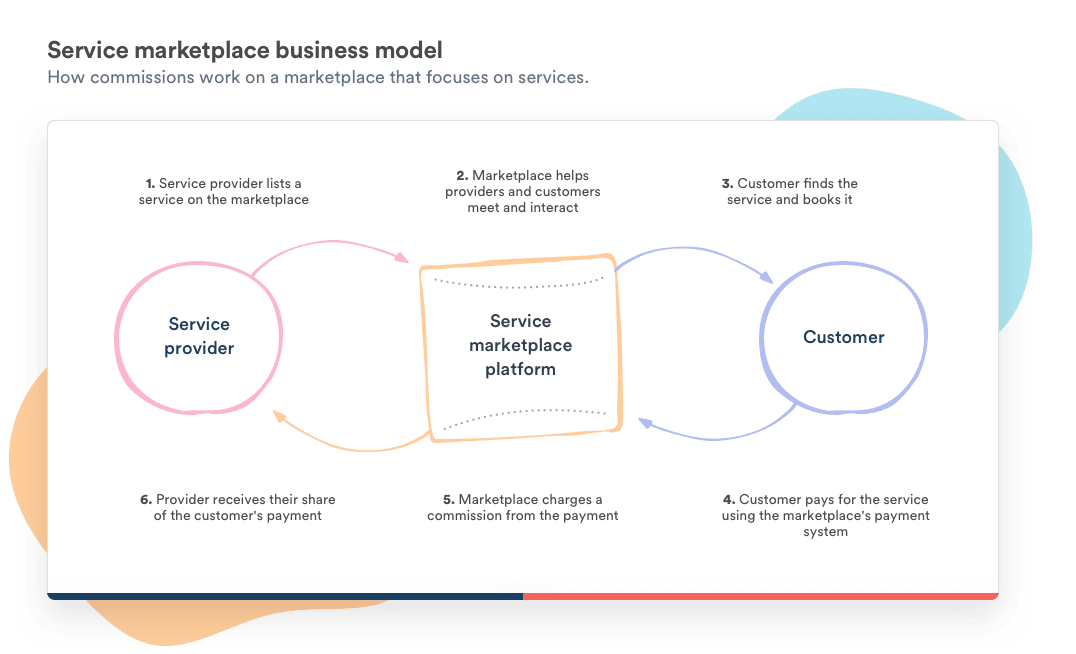
When we studied the business models of the top 100 marketplaces, we found out that service marketplaces can succeed with a wide range of business models.
Many favor a combination of a commission fee and a subscription fee. Or add even further revenue streams, such as one-off services or lead fees into the mix (the category "Other" in the graph below mostly consists of platforms who use several revenue streams on top of commissions).
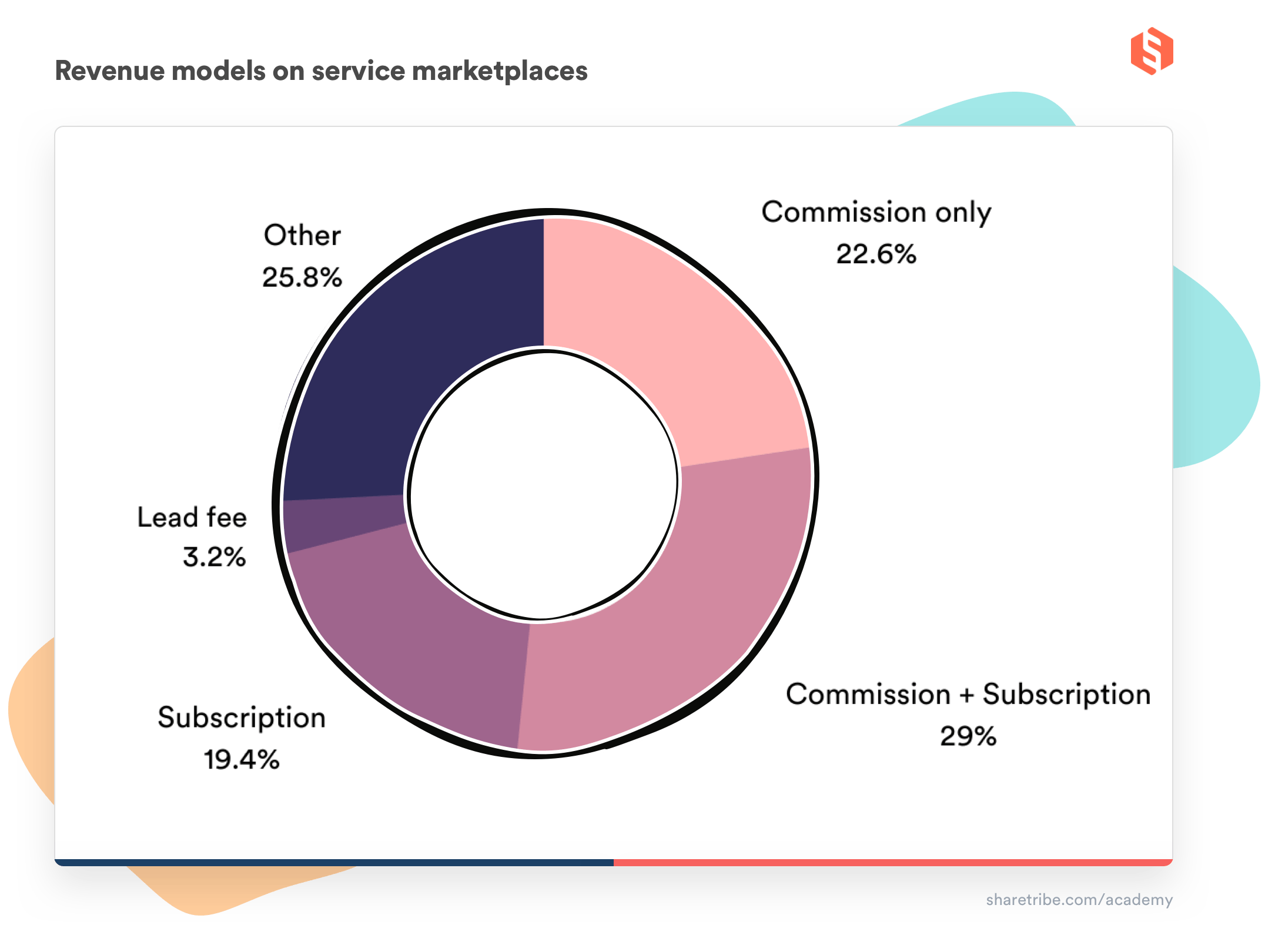
Commission is usually the fastest model to get your business off the ground because it's frictionless. Service providers can sign up for free, and only pay when they themselves make money.
A subscription fee, a membership fee, or a listing fee can be a good strategy if your customers are so difficult to find that your service providers are ready to pay to access them. Or vice versa. Some marketplace platforms may also sell ads or additional services.
Typically, these strategies are most useful as additional revenue streams on top of commission.
Most successful marketplaces start off with commissions only and add new revenue streams as the business matures.
Thanks to marketplace software, developing a marketplace website has become easier than ever before.
But building a platform isn't the hardest thing a marketplace entrepreneur faces. The biggest challenge is solving a real problem for two very different user groups: customers and service providers.
Here's a process I've seen work again and again for marketplace founders. I'll next discuss the steps in more detail and link to further reading on each of them.
- Find and validate your marketplace idea
- Build a marketplace website MVP (also covering essential marketplace features here)
- Build a user base
- Track and grow your business
- Build–Learn–Improve
Successful service marketplaces solve a real problem for both user groups extremely well.
To compete for the vast opportunities in the industry, your idea should achieve what Thumbtack did: make buying and selling services a lot faster, easier, and cheaper than it previously was.
Try to spot marketplace ideas by analyzing the services you encounter at work or in your free time. Look for
- inefficiencies
- underused assets
- fragmented markets
- services where you can add a layer of trust.
Does it take ages for you to find a repairperson for a specific task?
Is comparing office maintenance providers and asking for quotes so time-consuming that you just use the one you always have?
Would you be willing to pay someone to set up a Google Ads campaign, but find hiring and briefing a stranger too much of a hassle?
When you encounter a hurdle like this, stop and think about how a services marketplace could make the experience smoother.
It’s possible that someone else has come up with the same idea as you have. But don’t shy away from the competition immediately.
For example, there are many freelance and micro-jobs websites around.
But that doesn’t mean you shouldn’t build a website like Fiverr, Upwork, or Thumbtack.
A smaller player can win the giants by focusing on a small niche. FreeUp used this strategy and built a successful marketplace for hiring freelancers for online businesses. (Investor Fabrice Grinda believes this verticalization is a big trend for marketplaces.)
You could also analyze what people list on generic platforms that aren’t optimized for services. Are lots of professionals trying to offer certain services on Facebook Marketplace?
That might mean an opportunity for a service marketplace to improve the experience.
Have an idea in mind?
Before building anything, validate your marketplace idea by talking to potential users.
Try to understand what your assumptions about their problems are, and how well your marketplace idea can solve them. And, importantly: are they willing to pay for the solution your marketplace offers?
It’s difficult to predict how people will behave.
Your website might offer a specific service a lot cheaper than existing solutions. But is that enough to bring users in? Will they actually make the first transaction? And will they come back and use your marketplace again and again?
The best way to get answers to these questions is to launch your marketplace as quickly as possible.
That way, you can start learning from real users – and making real revenue – early on. The lessons you learn will give you an enormous competitive advantage.
The first version of the service platform you launch doesn't need to be perfect. In fact, we always recommend starting with building a Minimum Viable Product (MVP).
The MVP version of your marketplace should have the core service marketplace functionality that makes your users love using your website.
But nothing more.
Anything that isn’t essential is a waste of time and money in the beginning. You should use these resources to market your platform, learn from your users, and build your business.
There are many ways to develop a marketplace website. Sharetribe's no-code marketplace builder is the fastest way to get started, and you can expand your marketplace indefinitely with custom coding.
If you have some development skills and want to spend more time, it is possible to set up a marketplace with a website builder like WordPress. For even more time and skill, developing a marketplace app from scratch is a possibility.
However, consider carefully how much time you invest in building a platform. If you haven't validated your idea well, a lot of your work might go to waste.
Next, let’s look at the building blocks of a service marketplace MVP. (If you're using Sharetribe, all of these features are included out of the box.)
Ensure support for the service marketplace essential features
Users expect marketplace platforms to work in a certain way.
What is more, online service marketplaces are particularly vulnerable to platform leakage. That's where the customer and service provider use your marketplace to find each other but then make the payment outside of your system.
The temptation to do that is a lot lower if your marketplace features provide a lot of value.
 User accounts and profiles
User accounts and profiles
Profiles are particularly important for service marketplaces.
First of all, they're a tool for service providers to build their professional brand.
They also help you build trust between users with things like profile photos, background information, certificates, testimonials, and reviews. You could also add a user verification feature to your profiles.
So, your marketplace should let customers and service providers create an account, log in to your marketplace, and store their user information securely.
Both the providers and the customers usually first create a user profile before they do anything else.
 Listings and search
Listings and search
The type of services your platform offers determines the kind of listing features you need.
In any case, the service providers will want sufficient tools to showcase and market their offerings. Users should have powerful tools to browse, search, and filter listings based on their criteria.
The listing and search functionality is complicated to build, so consider carefully what is essential for your MVP.
This article on designing your marketplace search and discovery can be helpful.
 Availability & booking management
Availability & booking management
Availability and booking management is a crucial feature.
It lets service providers control when their services are available and prevent double bookings.
This can bring a huge improvement in your providers’ workflow – and help you prevent platform leakage. Give your providers great booking management tools and the trouble of circumventing your platform won't be worth it.
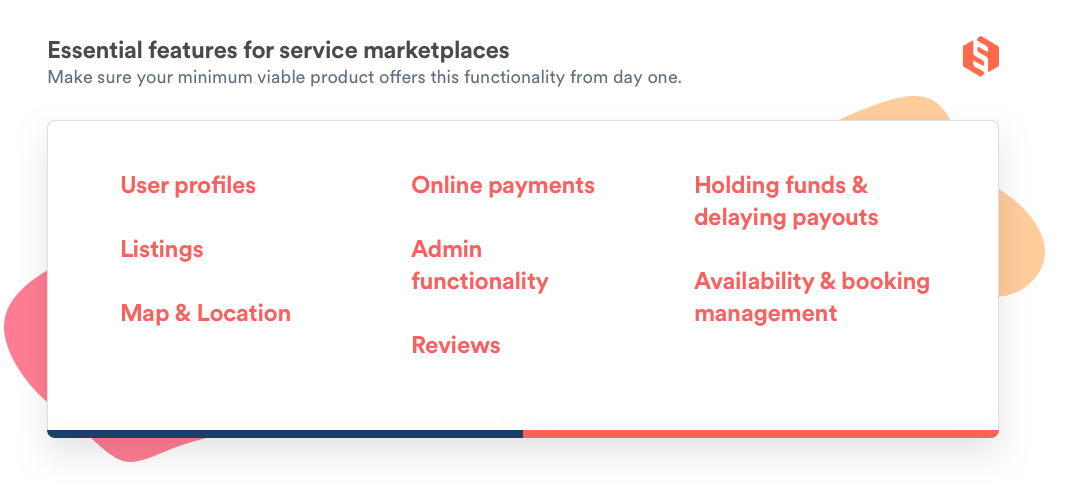
 Online payments
Online payments
Most marketplaces make money by charging a commission. This requires an elaborate marketplace payment system.
First, your marketplace needs to let customers pay with their desired payment method.
Then, you need to pay that money to the right provider, but only after you have deducted your commission. There are all kinds of legal and regulatory questions to take into account here.
If you're not using marketplace software with a pre-built payment infrastructure, integrating with a marketplace payment service provider is recommended.
 Holding funds & delaying payouts
Holding funds & delaying payouts
To add a layer of security, almost all marketplaces have a service called escrow.
Escrow means that a customer’s credit card is already charged when they book a service. The platform holds the payment until the service has been delivered and then pays the provider.
This arrangement protects both parties from fraudulent users.
 Reviews
Reviews
After a successful transaction, the service provider and the customer review each other. Often, the reviews are blind: a seller only sees their review after they've submitted theirs on the customer.
Double-sided reviews build trust between users.
They also help your service professionals build their brand. And might help you prevent leakage, too: a provider might see more value in adding a new review to their profile than in avoiding your commission.
 Admin functionality
Admin functionality
The service marketplace founder needs full control over the platform.
Typically, that means you need a dashboard where you monitor and access all user profiles, transactions, messages, and reviews.
Monitoring how your users behave can give you extremely useful insights, particularly in the early days.
To maintain trust, you also need to moderate content, block users, and edit payments whenever that’s called for.
 Map & Location
Map & Location
If your marketplace deals with local services like babysitters or photographers, you need a map and location feature. Providers tag their listings on a map, and customers can search for listings based on location.
If your marketplace only focuses on digital or remote services, a map isn't necessary.
After your service marketplace MVP is ready, it's time to launch it to your audience.
Or audiences to be precise. Marketplaces serve two very different user groups: service providers and customers.
Often, the best way to start building your user base is by bringing the service providers in first.
Service providers usually have an incentive to join your marketplace because it offers them useful booking and payment tools and helps them reach more customers. For customers, the only selling point you have is great supply.
Once you've seeded your marketplace with high-quality supply, you can do a marketing launch to customers. If you've validated your idea well, you already have some ideas on where to find them. Recruit your service providers to help your launch by spreading the word among their existing clientele.
Also worth checking out: Mike Williams' article on how to onboard and grow initial supply.
You now have a group of early users on your service marketplace. Now let's track their behaviour
Have a look at this article to identify your key marketplace metrics.
They might be different from what you think. For example, it's quite natural to get a boost of dopamine from seeing your user count go up. But volume isn't what you should focus on in the early days.
Instead, focus on reaching liquidity.
Liquidity means the likelihood of a seller making a sale on your marketplace and of a buyer finding what they're looking for.
If you ask any marketplace expert, investor, or founder, it's the north star metric for any marketplace. So focus first on reaching liquidity with your small initial user base.
Then, you can start identifying the marketplace growth strategy that let's you scale your illiquidity strategy to bigger markets.
Launching an MVP fast is the first step.
The second step comes when your marketplace starts growing. You look at how your users behave and interact, and where they hit bottlenecks in your platform. You learn what features you need to add to keep providing value and differentiating your brand from competitors.
This is the right time to invest in custom-developing your platform.
You've validated your idea with real users. And you've heard real user feedback. You know your investment won't be wasted.
So, build features you think can optimize conversion, boost customer lifetime, or prevent leakage. See what happens, then iterate.
And repeat. Win against competitors by investing your time and resources where your data tells you they count the most.

We've developed Sharetribe exactly for this iterative process.
Our no-code builder gives you all the essential features listed above – and more. You can have a service marketplace up and running in one day without writing a line of code.
Once you’re ready to take your business to the next level, you can custom-develop unique features and designs on top of your Sharetribe marketplace. You can still keep all the no-code features and benefits like backend hosting, maintenance, security, backups, and updates.
This approach can save you up to 90% of the time and cost of building a service marketplace.
But percentages are relative. Let's rather talk about concrete sums, the real costs of building a service marketplace.
What follows are, of course, rough estimations and averages. I've gotten to them by talking with various developers across our global developer network and by looking at how our customers are using Sharetribe today.
Services marketplaces are complicated websites.
Even the MVP version requires lots of features for both user groups, a powerful transaction engine, and admin functionality.
Building such a site from scratch is time-consuming and expensive.
Developer’s hourly fees vary, but typically, $50,000 is the minimum for a basic service marketplace feature set. Fees from hosting, third-party tools, maintenance, and updates come on top.
If you're comfortable with software programming, you can naturally avoid the building cost.
However, you should assign a monetary value to your own work. The most important resources founders have are their time and focus – be sure to spend them where they offer the biggest return on investment.
(If you're interested in exploring this option further, I recommend checking out this article on developing a marketplace app by our senior full-stack developer Mikko. It helps you estimate the scope of the project and choose your technology stack. If you'd like to compare different approaches, this article on different ways to develop a marketplace be helpful.)
To compare, here's a breakdown of two example budgets for the first year of using Sharetribe.
The first budget is for using Sharetribe's hosted, no-code builder.
The second budget is for building a fully custom marketplace on top of Sharetribe and self-hosting the front-end application. You can also start with the first and move to the latter once you're ready to scale.
In this example budget, we assume you're using Sharetribe to validate your idea and build your MVP and want to keep costs to a minimum.
In addition to building your service marketplace website, you’ll likely need to spend some money on branding and marketing.
Depending on your skill set and your particular niche, you might need to outsource design, buy fonts, images, or certificates, and pay for ads or marketing solutions. There's a lot you can do with affordable or free online tools.
With Sharetribe, you get a 14-day free trial to build your platform. If you need more time before launching, you can subscribe to an affordable Build plan at $29/month. So, the actual fee during your first year is likely to be lower than what's outlined below.
Your service platform
| Sharetribe Launch plan for 12 months (annual billing) | $2,388 |
| Domain registration for 12 months | $10 |
| Logo design – free using a tool like Canva | $0 |
| Stock images – free using a service like Unsplash | $0 |
Marketing & user acquisition
| Blog and content marketing (Sharetribe's Pages feature) | $0 |
| MailChimp email marketing – free up to 500 contacts | $0 |
| Google Analytics – free version | $0 |
| Total 1st year service marketplace budget with Sharetribe | $2,398 |
On top of this budget, you might want to consider buying traffic in the form of Google Ads, for instance.
However, getting a meaningful amount of traffic through paid advertising typically requires being prepared to spend at least $1,000 for relevant keywords per year.
Your Sharetribe-powered service platform got off the ground well, and you’re making a steady profit. You decide it's time to build unique functionality and start scaling your business to new markets.
How much does it cost to create a unique user interface and some powerful custom features?
For this estimate, I assume you outsource UX design and development to our Expert network. If you have these skills on your team, you naturally avoid these costs (and instead need to budget more on salaries).
At this stage, the estimate gets rough because prices for designs and development vary depending on hourly rates and the extent of our customization needs.
Sharetribe is specifically designed to power service marketplaces, so its off-the-shelf features should take you pretty far already. You might need to add just one or two features at a time over many months. The following budget is for a full custom-development project, including visual design and unique functionality.
Your service platform
| Sharetribe Extend plan for 12 months (annual billing) | $3,588 |
| Transaction fees for an average of 1,000 transactions per month (500 transactions are included in the plan) | $1,140 ($95/month) |
| UX design and wireframes | $1,500 |
| Custom development | $5,000 |
| Front-end hosting | $360 |
Marketing & user acquisition
| MailChimp Standard plan for up to 25,000 subscribers | $2,976 |
| Google Analytics – free version | $0 |
| Total 1st year custom service marketplace budget on Sharetribe Extend plan | $14,564 |
At this stage, you know your market and customer lifetime value so well that you know where paid user acquisition makes sense. But these efforts should be net positive: your customer acquisition cost is lower than customer lifetime value.
The Sharetribe Build plan has a free 14-day trial and is only $29/month after that, also on the Extend plan. Developing and building your marketplace with Sharetribe is easy and affordable.
You can create your Sharetribe account and start a free trial here. If you don't have a developer on your team, we're happy to match you with a verified Expert developer. Learn more about custom development services for Sharetribe. Or check out our helpful guide on how to hire a marketplace developer for some useful advice!
Sharetribe powers over 1,000 marketplaces around the world. Here are some of our favorites – check out our customer gallery for more Sharetribe examples or read our founder stories!

Probuddy
Probuddy is a platform for booking private educational tutors and sports coaches.
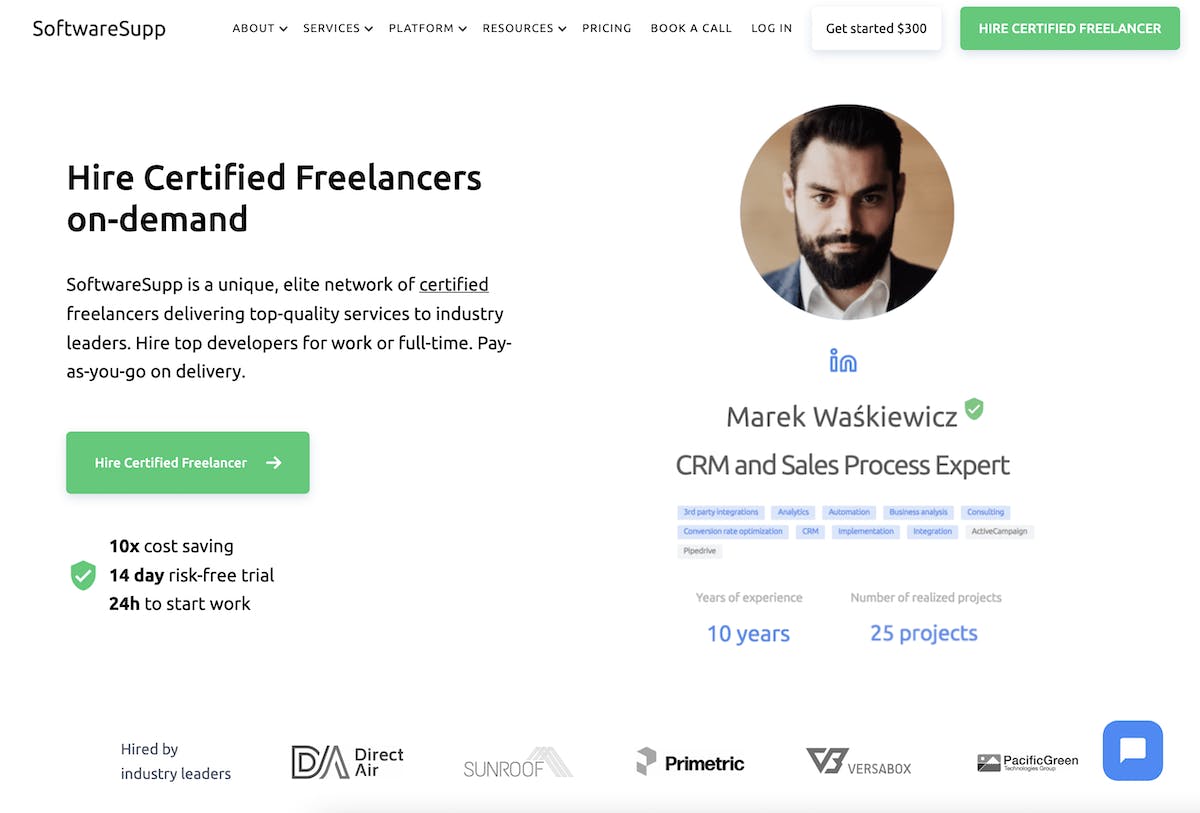
SoftwareSupp
SoftwareSupp is a marketplace for hiring a freelancers for software projects.
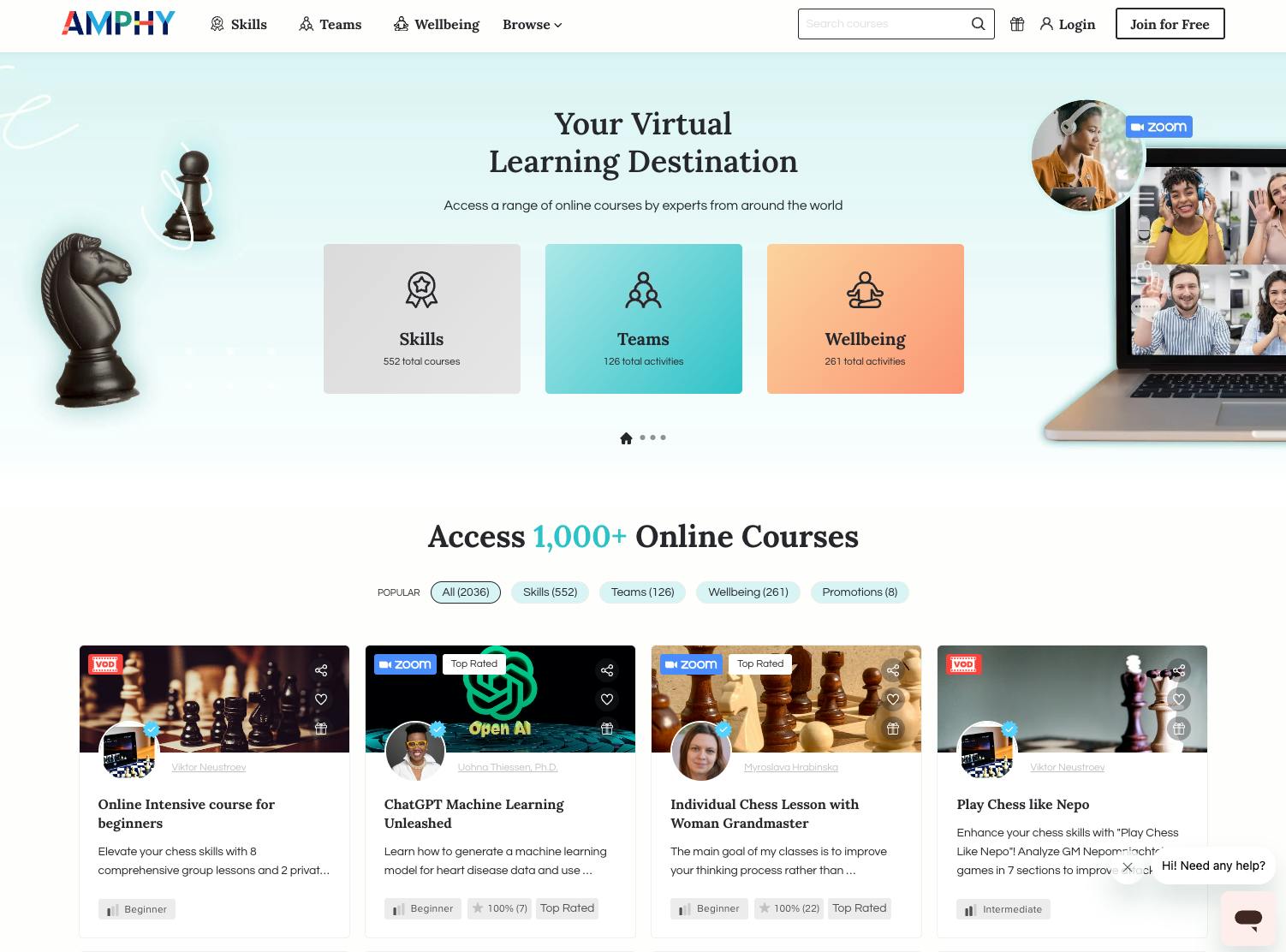
Amphy
Amphy is a marketplace for online learning.
Building a service marketplace can sound like a daunting task.
Today's users are familiar and comfortable with eCommerce. At the same time, they expect a flawless user experience.
Service marketplaces are complicated websites to build, and the business model can be tough to master.
Don't let the challenge discourage you.
Take the iterative approach and move your business idea forward one step at a time. You'll accumulate experience and understanding that give you a real competitive advantage.
If you're interested in reading more, our Create a marketplace guide is a great place to start working on your business step by step. It's helpful whether you're building your marketplace website with Sharetribe or not.
Best of luck with your service marketplace!
Start your 14-day free trial
Create a marketplace today!
- Launch quickly, without coding
- Extend infinitely
- Scale to any size
No credit card required
